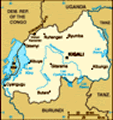Advertisement
Published: July 18th 2012
The first association most "westerners" make upon hearing the word "Rwanda" is the 1994 genocide, and the collective guilt of the whole world for not stopping it. Many nations sent troops to evacuate their own citizens. These troop numbers would have been sufficient to stop the slaughter - had they been given that mandate. Or, if the UN higher ups had not stopped the UN Peace Keeping commander on the ground, who having learnt about a large weapons cache intended for use in the upcoming planned massacre, requested authorization for him to go and confiscate those weapons... or if the Belgium government had refused to be pawns in the game when they pulled their paratroopers out of the UN forces after 10 of them were killed at the start of the slaughter ... or ... the list goes on ...
Yes. The Kigali Genocide Memorial is a must see. It is not as graphic as other memorials in Rwanda. But, it's hard to ignore the over 250,000 mass graves of victims in the garden. It has 2 floors of displays. The bottom floor is a series of exhibits, including photos, video, and display cases of weapons, bones, and clothing of
victims. There was video from survivors and one area dedicated to remembering the children who were killed - often by the neighbours they played with regularly.
Thankfully, there's no so called journalistic "balanced approach" ... the story is told primarily from the side of the victims, going back in history to the colonial powers who consistently and cynically exploited any existing societal divisions to make colonialism last longer. Yes, there were many slaughters before 1994 too ... nobody is blameless ... the religious heads of churches who collaborated with the killers are named along with journalists who only covered the "refugee crisis" in neighbouring countries ... and especially France for being so blatantly one sided - on the side of the killers ... and the UN for the lack of a spine ... yes, it's a long list to blame. Didn't France just end up doing a very similar stunt again in the Ivory Coast?
The upstairs is dedicated to genocides that have happened elsewhere ... such as the German colonial genocide in Namibia, the post-Yugoslav Balkans with their ethnic cleansings, the Khemer Rouge in Cambodia, the Germans again in Treblinka and other death camps, the Ottoman Turks

 The Hotel Rwanda
The Hotel Rwanda
Hotel Des Mille Collines was the hotel featured in the movie "Hotel Rwanda"in Armenia ... it's a long list ... What's happening in Syria right now?
There were some good things too ... like the Hotel Des Mille Collines ... when abandoned by the European management ... was taken over by a Rwandan, Paul Rusesabagina, who made it a safe haven for a while ... at great risk to himself and his family ... this was the inspiration for the movie "Hotel Rwanda" ... Not all religious authority was bad ... just like in colonial times, there was some good deeds performed by a minority of church leaders too.
I found the personal portraits of victims the most haunting ... just like the S21 prison in Phnom Penh, Cambodia ... the pictures of the children especially ... I didn't feel as haunted as I did in the slave market in Stone Town, Zanzibar or Tuol Sleng S21 prison in Phnom Penh ... maybe because the mass grave outside was just a large series of concrete bunkers with no way of identifying the individuals buried within. But, it is sad nonetheless.
I don't know if this was intentional ... but the textual descriptions beside the displays was very hard to
read ... given the intentionally dark lighting, small font, and low contrast colour typeface ... come to think of it now ... it has to be intentional ... but, I found it made the stories harder to follow ...
Now, 18 years after, Rwanda and especially Kigali is healing. There's no sign of dogs on the streets. They were killed off after aquiring a taste for human flesh following the 100 days of slaughter. The rate of killing was even more efficient than that at Treblinka ... the most efficient of the German killing factories ...
The economy is definitely growing and doing well ... there's modern buildings, and a feel of vibrancy throughout Kigali. It's perfectly safe to go out at night. There's young people in fashionable attire talking on their mobiles.
I love walking around in cities. But, in Kigali that is very hard to do, since the hills are much steeper than the 7 hills of Kamapala, and the city is spread out over a greater area. I did spend the better part of the afternoon walking all over, but had to resort to a motor cycle taxi a couple of times when the
distances and terrain were just too tough ...
I'd planned on having a lunch time snack at the Hotel Des Milles Collines ... but, I'd got so hopeless turned around, that I'd just finished a snack when I meandered into the hotel, almost by accident. Doesn't help when none of the streets names are sign posted. So, no lunch at the poshest address in Kigali. I did walk around it though.
Tomorrow I travel to Bujumbura, Burundi.
Advertisement
Tot: 0.076s; Tpl: 0.011s; cc: 9; qc: 41; dbt: 0.0472s; 1; m:domysql w:travelblog (10.17.0.13); sld: 1;
; mem: 1.1mb










